| Click Here to View VSI Newsletter in Browser |
 |
||||||||||||||||||
This Newsletter Has Been Generously Sponsored By:
|
||||||||||||||||||
|
Dear VSI Members, Friends, and Donors, Each fall as our vitiligo boys and girls head off to a new school year, VSI begins to receive requests for information, and suggestions for ways to help the acclimation process into new school environments and situations. We all want to protect our children from harm, but we can’t be with them all the time. With so many stories in the news about bullying, this is a topic on the minds of many concerned parents. While we have to accept that there are many things out of our control, by providing a nurturing and supportive home environment, and working to identify and overcome personal obstacles, we can try to strengthen our children’s foundation of support. Research has identified personality traits that can make a child more vulnerable to bullying, such as being introverted, submissive, or anxious. Recognizing these traits early in life can help identify problems and enable these children to develop coping mechanisms and behavioral strategies to help improve problem areas. It’s always important to understand that bullying is the result of an individual acting out due to his or her own personal insecurities. Bullies lash out in an effort to draw attention away from their own weaknesses. Bullies not only target those they feel they can dominate. They also target those they are jealous of, such as athletic and popular students, or those who are very bright and make good grades. When a bully doesn’t make the team or receive academic accolades, they deflect their personal embarrassment by trying to belittle the achievements of others. If the target of the bullying pays no attention to the words and actions of the bully, then it’s no fun. The bully will move on to the next target. Research has also shown that children with few friends are more often the targets of bullying. These are the children spending their lunch or recess alone. Teachers can help by introducing a shy child to a group of friends and pointing out things they may all have in common. Parents can help by encouraging their child to invite a new friend over to their home, or to go out to a fun activity together. I saw this post on social media the other day and thought it worth passing on:
Click Below for Additional Resources for Children, Parents, and Teachers.
Each passing year that VSI has served the vitiligo community, we’ve seen an increase in demands, responsibilities, and expectations. Although funding has continued to increase incrementally, it’s not kept pace at levels sufficient to meet the ever-increasing demands with desperately needed staffing assistance.
Where Does Your Funding Go? Toward... Maintaining a dedicated office, office equipment, supplies, monthly utilities, and one full-time staff person. Has Anyone Noticed VSI’s New Website? Educational Resources: Professional and educational meeting attendance and presentations, maintaining updated resources, national advocacy and awareness, website hosting, security, and licensing …. All of the above requires funding.
Where Do We Stand? I am encouraged to report that contributions continue to come in at a pace ahead of this time last year. However, the fact remains that we are now three-quarters of the way through 2019, and have raised only 38% of our goal. Each and every donation, large or small, makes a difference.
VSI Would Like to Thank our 21 Recurring Monthly Donors Sincerely,
Why Did I Get Vitiligo? VSI often hears questions from those recently diagnosed such as: “Why did I get vitiligo? “Is it contagious?” “How can it be hereditary when no one else in my family has ever had it?” To begin with, no, vitiligo is most definitely NOT contagious! Regarding heredity, just because no one else in your family currently has vitiligo, doesn’t mean that they may not develop vitiligo at a later time, or that there are no genetic links to vitiligo in your family. To answer the question of why one person in a family has vitiligo and others do not is not simple. Vitiligo, by definition, is a complex, multifactorial, polygenic disease. What does that mean?
As noted above, there are many factors involved with developing vitiligo, beginning with the different combinations of genes each person inherits from their parents.
In my family for instance, some people say I look more like my maternal aunt than my mother. Most likely that’s because my aunt and I both share some of the same genes from my mom’s side of the family. Each child inherits different sets of genes from each parent. One might inherit blue-eyed genes and another brown. One might inherit a small number of vitiligo susceptibility genes, while another inherits a wide array of them. Kind of like the ice cream cones below: some have a large concentration of various colors of sprinkles, while others have less or very few, and each has different combinations.
While the genetic or biological components may play a significant role in a person’s susceptibility to vitiligo, research indicates that this genetic predisposition may factor as little as 30% toward disease development, with the environmental factors weighing in closer to 70%, as evidenced by identical twins. Even though they share identical DNA, both develop vitiligo only 23% of the time.
This indicates that there are also significant, non-genetic, (environmental) components that sometimes serve as the catalyst, or trigger, for the onset, or worsening of vitiligo. For example, one twin may have experienced a great deal of emotional stress, such as the death of a close friend, and developed vitiligo at age 22. Without that stress, the other twin could develop vitiligo later in life, or never. What are Environmental Factors? Environmental factors, also referred to as environmental triggers, are non-genetic, environmental, and lifestyle factors that may play an important role in triggering the development and progression of autoimmune (A/I) disease/s in those who are already genetically predisposed (by having the genes) to the disease/s. Environmental triggers such as bacterial and viral infections, chemical toxins, environmental pollutants, diet, and food allergies, have been blamed for immune dysregulation leading to autoimmune activation. Research has also shown insufficient vitamin D levels, chronic emotional/psychological stress, and skin trauma to be vitiligo triggers. Chemical-Induced Vitiligo A variety of industrial chemicals, as well as household and cosmetic products, have been identified as triggering “chemical-induced vitiligo.” Some of the most well-known are the phenol-based derivatives found in hair dyes, which have been shown to cause pigment loss not only at the site of exposure (where applied) but, over time, may result in progressive, generalized vitiligo, with pigment loss spreading to remote areas of the body that were not exposed to the chemical/s. The product label below is from a men’s black hair dye, and includes the following warning citing vitiligo as a possible side effect. You may recall VSI’s previous newsletter report about Kanebo, a cosmetic company in Japan that sold skin-lightening products containing the active ingredient rhododenol [4-(4-hydroxyphenyl)-2-butanol] that resulted in nearly 20,000 consumers developing vitiligo-like depigmentation. The company initiated a voluntary recall of 54 skin whitening products affecting nearly 5 million sales in 11 Asian countries. You can read more about that in VSI's Summer 2018 Newsletter. A variety of products, from cosmetics, adhesives, and household disinfectants, to occupational and commercial chemicals, have been specifically identified as potentially problematic to those with vitiligo. Koebner-Induced Pigment Loss
The Koebner effect is defined as pigment loss occurring at the site of an injury or skin trauma, such as cuts, scratches, and burns, or friction, such as the waistband where clothing rubs.
Recognizing Stress Stress is commonly defined as physical, psychological, or emotional experiences that cause tension. Chronic, or persistent, stress, such as job- related problems, financial difficulties, or unhealthy interpersonal relationships can lead to chronic health problems such as heart disease, high blood pressure, or A/I diseases. One example would be public speaking. Some people enjoy the limelight and look forward to giving presentations, while the exact same situation for others can cause dread, anxiety, and even loss of sleep for weeks or months in advance. It’s also important to note that not all stress comes from negative experiences. There are times that positive/happy events can bring major stress into your life. Examples might include planning a wedding, getting married, moving into a new home, or enduring home renovations. Stress and Vitiligo Dr. Caroline LePoole and researchers from Loyola University in Chicago, IL have delved deeply into the scientific causes and pathways tying emotional stress to the onset or worsening of vitiligo. Their research was responsible for the discovery of the inducible heat shock protein 70 (HSP70i), released by cells like melanocytes (pigment making cells) when under stress. These cells are known to play a pivotal role in the development of vitiligo. Several years ago VSI conducted a (non-scientific) poll
The Family Connection? While there are many pieces involved in the puzzle of when, or which person will develop vitiligo, there are clues to look for that may help pinpoint other family members that might be carrying susceptibility genes. A good place to begin is by identifying the type of vitiligo you have, which is relevant for several reasons beginning with treatment therapy options, which vary between the types. But it’s also important because the different types of vitiligo are associated with the potential of different underlying conditions. Many times, it is the underlying conditions that not only help identify other family members who may share common risk genes, but also provide a bigger picture of just how many risk factors may have been involved with the eventual tipping point leading to the development of vitiligo. There are three primary types of vitiligo
Non Segmental Vitiligo (NSV), also known as generalized vitiligo, is the most common type. One of the most significant and distinguishing characteristics of NSV is its autoimmune association. Because the development of most A/I diseases includes a substantial hereditary component, the A/I connection is a key piece of the genetic puzzle linking vitiligo to other family members. Autoimmune diseases are sort of like a family tree in the way that some A/I diseases interrelate with others by sharing some of the same genes. This connection helps explain why some AI diseases occur together more frequently in what researchers and physicians refer to as a cluster. Some of the other A/I diseases in vitiligo’s cluster, more commonly found among those with vitiligo as well as their extended family members, include autoimmune thyroid disease (AITD), type 1 diabetes, inflammatory bowel disease (IBD), rheumatoid arthritis (RA), and pernicious anemia. In the diagram below, the cross-over, or intersection that you see, illustrates the underlying risk genes that the different A/I diseases share, or have in common.
Autoimmune thyroid disease (AITD) is the most prevalent A/I disease found among vitiligo patients, with research showing the risk to be 2.5 times higher than in the normal population. Because of this increased incidence and the potential for its health impact, it is recommended that all vitiligo patients receive an annual thyroid screening. In addition to autoimmunity, other NSV characteristics include: Both sides of the body are involved, with pigment loss often in a mirror type manner. Itching (pruritus) ranging from mild to intense, may occur at the involved site prior to noticeable pigment loss, resolving after the depigmentation. This is theorized as an inflammatory autoimmune response, occurring in those affected during active phases of vitiligo. Some people describe other sensations such as warmth, burning, or stinging, as well as tingling, and crawling in these same locations. Many of those who experience this symptom report it to be significant enough to impact their daily life, as well as causing sleep disturbance.
Premature graying of hair, defined as more than 50% white hair on the head before the age of 40, is more often noted in the family history (immediate and extended family members) of those with NSV. Scientists hypothesize that those with premature gray hair share common A/I predisposing genes with vitiligo.
NSV Treatments There are 2 primary types of treatment used for repigmentation of NSV. Topicals - such as mid-to-potent strength topical corticosteroids like clobetasol, and calcineurin inhibitors like Protopic (tacrolimus) and Elidel (pimecrolimus) Phototherapy - such as narrowband UVB (NB-UVB), UVA, and excimer laser Click here for additional information on treatments. Segmental Vitiligo (SV), most often begins at an early age (12 years and under), and is not typically associated with autoimmunity. In contrast with NSV, segmental usually affects a confined area on one side of the body, such as one side of the mouth or neck. More than half of those affected by SV will also have patches of white hair on the affected areas, as seen here on the eyelashes. SV Treatments For many years it was thought that SV didn’t respond to the more conventional treatments offered to those with NSV. However, years of research, providing a better understanding of the nature of the disease, has disproven this notion. Unlike NSV, which generally begins with a few small spots and spreads slowly, the rapid spreading of SV at the onset quickly involves the follicular melanocyte reservoir (where the pigment-making cells are generated). If not treated early, the reservoir can become depleted and unable to generate new melanocytes, which helps explain the loss of hair pigment. Consequently, we now know that aggressive, combination therapies with treatments such as topicals, phototherapy, and oral steroids, offered very early after onset, can be quite successful. Multiple research studies have reported patients regaining from 50% up to complete repigmentation, with the best outcomes among those treating within 5 to 12 months of onset. Surgical procedures such as grafts and cell transplants are typically reserved for those with stable vitiligo, as they have a much lower risk of relapse, making those with SV prime candidates for these procedures. Mixed Vitiligo (MV) is defined as when a person first develops segmental vitiligo that later progresses into nonsegmental vitiligo, becoming “Mixed.” The diagram below from the 2012 French study shows the rate of occurrence of the characteristics experienced by NSV and SV patients in their study. You'll see that symptoms such as pruritus (itching) and halo nevi, occur in significant numbers among the NSV patients, but in negligible percentages of the SV group. The areas of overlap are flags for potential of later progression to MV.
Because of the predisposition to autoimmunity associated with NSV, researchers advise that SV patients who exhibit signs of autoimmunity such as itching, halo nevi, or thyroid antibodies, should be carefully followed up because of a possible increased risk for MV. Recognizing these symptoms early provides the opportunity of early diagnosis and treatment. Vitiligo Family Connection – Unraveling the Mystery Going back to the question of how vitiligo can be hereditary when no one else in a family has ever had it - as mentioned above, the autoimmune connection likely provides the greatest number of clues. If anyone in your immediate or extended family has experienced premature graying of hair, moles surrounded by a white ring or halo (halo nevi), or has been diagnosed with any of the A/I diseases in the vitiligo cluster, especially autoimmune thyroid disease, chances are that they, too, share some of the same genes in the vitiligo pool. Who Will Get Vitiligo? While genetic research in recent years has made tremendous discoveries, there are times when it seems the more we learn, the more we realize how much we still don’t know. Researchers hypothesize that the more risk factors there are involved, the more likely a person is to develop an autoimmune disease. Envision a healthy immune system like a balanced see-saw. Everyone has setbacks from time-to-time offsetting the balance. However, it’s unlikely that a single gene or experience would trigger the onset of an A/I disease. It’s more likely to be a long term cascade of events and stresses. The more risk factors you add, the closer you come to tipping the balance toward disease development. Knowing your family history can help identify potential health risks in your family genes, giving you a chance to proactively reduce risks with early testing and diagnosis. Combining this knowledge with a healthy lifestyle is your best defense against disease development.
Calling all Medicare Vitiligo Patients!
Part of the problem is that currently there is no accepted standard for coverage of vitiligo treatments. Each company has their own policies and guidelines, many times based on outdated and incorrect information. What most people may not realize is just how much private insurance coverage can be affected by Medicare policies. Over 55 million Americans are now covered by Medicare or Medicare Advantage, making it the nation’s largest health insurance program. Consequently, many, if not most, insurance providers establish their baseline standards and procedures to follow the Medicare model. Medicare has agreed to meet with us – but requires that we bring Medicare letters of denial for a vitiligo treatment. If you are reading this newsletter and you, or someone you know, was denied coverage for a vitiligo treatment by Medicare, please contact VSI immediately. You could help make a difference for future insurance coverage for ALL vitiligo patients! Click Here to Contact VSI
What's On Your Mind? Q. I’ve read that vitiligo is not contagious, but my husband developed vitiligo about 18 months ago, then I was diagnosed about 6 months ago. Don’t you think this is odd?
Q. I’ve been using NB-UVB light treatments for several months for vitiligo. My husband and I are considering starting a family. Is it safe to continue the light treatments if I become pregnant?
Highlights of recently-published medical Vitiligo Triggered by Anti-inflammatory Sulfa Drug To reduce inflammation caused by the dermatitis herpetiformis, the patient was prescribed a sulfa-based anti-inflammatory drug called sulfasalazine (Azulfidine), often prescribed for autoimmune conditions such as rheumatoid arthritis, Crohn’s disease, ulcerative colitis, and inflammatory bowel disease. Over the course of 11 months of treatment, the patient developed rapidly progressive generalized vitiligo, which was confirmed by a biopsy. The researchers noted: “To the best of our knowledge, this is the first case report which has demonstrated the possible biochemical pathways, triggered by sulfasalazine, in the development of vitiligo.”
Reduced Risk of Internal Malignancies With over 10 years of research showing those with vitiligo to be at least 3 times less likely to develop skin cancer than the normal population, a Korean research group recently published findings from a 9 year population-based retrospective cohort study investigating the risk of internal malignancies in patients with vitiligo. The study was confined to physician-diagnosed vitiligo patients aged 20 years or older, and a control group, frequency-matched for age and gender. They compared incidence rates of internal malignancies between 101,078 patients with vitiligo and 202,156 controls. After adjusting for age, sex, and comorbidities, they found a significantly reduced risk of overall internal malignancies among those in the vitiligo group. The vitiligo patients experienced a remarkably decreased risk of organ-specific malignancies in the colon and rectum, ovaries and lungs. They concluded that vitiligo may provide immune surveillance for the development of cancers beyond just the skin.
Jak Inhibitor Study
Research Study in New York City
Earn Funding for VSI with Amazon and eBay Online Shopping Can Benefit VSI!
Support VSI Through Ebay
|
||||||||||||||||||
| Copyright © 2019 Vitiligo Support International Inc. All rights reserved. Reproduction or republication strictly prohibited without prior written permission A Vitiligo Support International, Inc. financial statement is available upon written request from the Virginia Office of Consumer Affairs. Mail requests to: Virginia Department of Agriculture and Consumer Services, Office of Consumer Affairs, P.O. Box 1163, Richmond, Virginia 23218. |
||||||||||||||||||




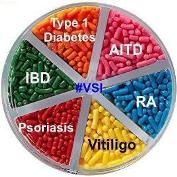 Think of the genes in your DNA as candy sprinkles. Each color carries susceptibility to a different trait or disease. Your mother might carry the genes for green eyes, short in stature, type 1 diabetes, and psoriasis, while your dad might carry genes for brown eyes, tall in height, vitiligo, and irritable bowel syndrome.
Think of the genes in your DNA as candy sprinkles. Each color carries susceptibility to a different trait or disease. Your mother might carry the genes for green eyes, short in stature, type 1 diabetes, and psoriasis, while your dad might carry genes for brown eyes, tall in height, vitiligo, and irritable bowel syndrome. 
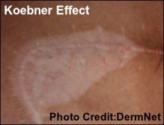
 One of the first steps in controlling the stress in your life is recognizing your stressors. In doing so, it’s important to note that stress perception is unique to each individual. Something that causes stress for one person may not be a problem for another.
One of the first steps in controlling the stress in your life is recognizing your stressors. In doing so, it’s important to note that stress perception is unique to each individual. Something that causes stress for one person may not be a problem for another. 
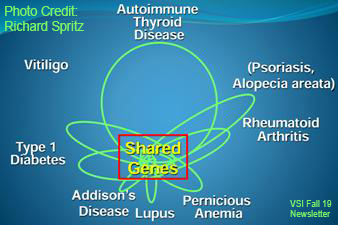
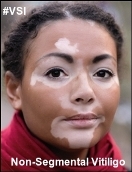
 From a diagnostic point of view, this symptom can be helpful in identifying active vitiligo before pigment loss is visible, enabling early treatment. However, this can also be a double-edged sword. The subsequent scratching can induce a Koebner response, further exacerbating the situation. It’s wise to consult your physician as soon as possible and begin treatment to both to ease the itching and to catch pigment loss before it spreads. Many people report that the topical corticosteroids prescribed for vitiligo help with this.
From a diagnostic point of view, this symptom can be helpful in identifying active vitiligo before pigment loss is visible, enabling early treatment. However, this can also be a double-edged sword. The subsequent scratching can induce a Koebner response, further exacerbating the situation. It’s wise to consult your physician as soon as possible and begin treatment to both to ease the itching and to catch pigment loss before it spreads. Many people report that the topical corticosteroids prescribed for vitiligo help with this. 

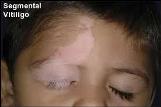



 While NB-UVB is generally considered safe for pregnant patients, studies have shown that UV radiation can reduce or deplete the body of folic acid. This reaction to UV radiation is more pronounced in lighter-skinned individuals, and less with darker skin.
While NB-UVB is generally considered safe for pregnant patients, studies have shown that UV radiation can reduce or deplete the body of folic acid. This reaction to UV radiation is more pronounced in lighter-skinned individuals, and less with darker skin.
